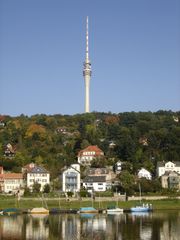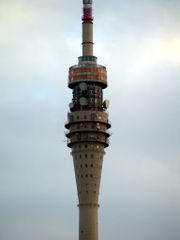
Fernsehturm Dresden-Wachwitz
Encyclopedia

Dresden
Dresden is the capital city of the Free State of Saxony in Germany. It is situated in a valley on the River Elbe, near the Czech border. The Dresden conurbation is part of the Saxon Triangle metropolitan area....
, Germany
Germany
Germany , officially the Federal Republic of Germany , is a federal parliamentary republic in Europe. The country consists of 16 states while the capital and largest city is Berlin. Germany covers an area of 357,021 km2 and has a largely temperate seasonal climate...
. It is situated on the Wachwitzer Elbhöhen and serves as a transmitting tower for television and radio broadcasts. Due to its visibility over large distances and its unusual form, it has become a landmark
Landmark
This is a list of landmarks around the world.Landmarks may be split into two categories - natural phenomena and man-made features, like buildings, bridges, statues, public squares and so forth...
of Dresden and the Elbe Valley. Its address is 37 Oberwachwitzer Way, Dresden.
Construction
The architects of the Dresdner TV tower were Kurt Nowotny, Hermann Rühle and Johannes Braune. Built between 1963 and 1969, its cup-like design was inspired by a sparkling wine glass. It is 252 metres high and is the second highest building in the former GDR after the Berlin TV tower, which is 368 metres high. The tip of the building towers above the ground at approximately 373 metres and foot is 230 metres above sea level. The shank of the building consists of reinforced concrete and has a diameter of 21 metres, which is buried underground to a depth of six metres in Lausitzer graniteGranite
Granite is a common and widely occurring type of intrusive, felsic, igneous rock. Granite usually has a medium- to coarse-grained texture. Occasionally some individual crystals are larger than the groundmass, in which case the texture is known as porphyritic. A granitic rock with a porphyritic...
. The total weight of the tower amounts to 7300 tonnes.
Radio engineering
On September 18, 1969, radio transmissions were started from the tower. It possesses four transmission mechanisms for VHF broadcasts and three transmitters for television. In 2003, a small fire occurred in the transmitting rooms, which was quickly brought under control.Analogue radio (FM)
- 89.2 MHz: R.SA
- 90.1 MHz: MDRMitteldeutscher RundfunkMitteldeutscher Rundfunk is the public broadcaster for the federal states of Thuringia, Saxony and Saxony-Anhalt...
Jump - 92.2 MHz: MDR Radio 1 Sachsen
- 93.2 MHz: Deutschlandradio KulturDeutschlandradio KulturDeutschlandradio Kultur is the culture-oriented radio station of the German national Deutschlandradio service...
- 95.4 MHz: MDR Figaro
- 97.3 MHz: DeutschlandfunkDeutschlandfunkDeutschlandfunk is a German public broadcasting radio station, broadcasting national news and current affairs.-History:Broadcasting in the Federal Republic of Germany is reserved under the Basic Law to the states. This means that all public broadcasting is regionalised...
- 100.2 MHz: Energy Sachsen
- 102.4 MHz: Radio PSR
- 103.5 MHz: Radio Dresden
- 105.2 MHz: Hitradio RTL Sachsen
- 106.1 MHz: MDR info
Digital radio (DAB)
- Block 12A (223.936 MHz):
- Deutschlandfunk
- Deutschlandradio Kultur
- MDR Klassik
Analog television (PAL)
- UHF 59 (visual 775.25 MHz, aural 781.25 MHz): Dresden Fernsehen
Historical broadcasts

Deutscher Fernsehfunk
Deutscher Fernsehfunk , known from 1972 to 1990 as Fernsehen der DDR , was the state television broadcaster in East Germany.-Foundation:...
) was transmitted from the tower between 1969 and 1990. The first programme (DFF/DDR-FS/DDR1/DFF1) was on channel 10, with the second programme (DFF2/DDR2) broadcasting on channel 29 from 1972. DFF2/DDR2 broadcast in SECAM
SECAM
SECAM, also written SÉCAM , is an analog color television system first used in France....
colour. This was deliberately different from the West German PAL
PAL
PAL, short for Phase Alternating Line, is an analogue television colour encoding system used in broadcast television systems in many countries. Other common analogue television systems are NTSC and SECAM. This page primarily discusses the PAL colour encoding system...
standard, so East German residents could not watch West German broadcasts in colour. In practice, however, few East Germans owned colour sets, and reception of both standards was possible in black-and-white.
Dresden, because of its location in a valley, was one of the few areas of East Germany (and the only major city in the country) that could not receive the broadcast of West Germany
West Germany
West Germany is the common English, but not official, name for the Federal Republic of Germany or FRG in the period between its creation in May 1949 to German reunification on 3 October 1990....
's Das Erste from either Ochsenkopf
Ochsenkopf TV Tower
The Ochsenkopf Transmitter is a 163 metre tall radio and TV tower of reinforced concrete, which was built in 1958 as replacement for a 50 metre tall guyed steel tube TV mast, which collapsed in January 1958 as result of icing, on the summit of the 1024 metre high Ochsenkopf mountain, the second...
or West Berlin, despite the best efforts of West German broadcasters to cover the whole of the East. This led to Dresden and the surrounding area being called "Tal der Ahnungslosen" ("The Valley of the Clueless"), because its citizens only had access to the propaganda of East Germany. ARD
ARD (broadcaster)
ARD is a joint organization of Germany's regional public-service broadcasters...
, the company in charge of Das Erste, was said to stand for "Außer ("except") Rügen
Rügen
Rügen is Germany's largest island. Located in the Baltic Sea, it is part of the Vorpommern-Rügen district of Mecklenburg-Vorpommern.- Geography :Rügen is located off the north-eastern coast of Germany in the Baltic Sea...
und Dresden" or rather "Außer Raum Dresden" ("except/outside of Dresden area").
The two East German programmes were replaced upon reunification by Das Erste
Das Erste
Erstes Deutsches Fernsehen , marketed as Das Erste , is the principal publicly owned television channel in Germany...
and MDR Fernsehen, respectively, with ZDF
ZDF
Zweites Deutsches Fernsehen , ZDF, is a public-service German television broadcaster based in Mainz . It is run as an independent non-profit institution, which was founded by the German federal states . The ZDF is financed by television licence fees called GEZ and advertising revenues...
broadcasts commencing on channel 46. All analogue transmissions of public stations from the tower ended on 22 July 2007. Analogue transmission of the commercial networks, which began with reunification, ended at different times. Broadcasts of RTL
RTL Television
Rtl.de' redirects here. For other uses, see RTL.RTL Television , or simply RTL, is a German commercial television station distributed via cable and satellite along with DVB-T , in larger population centres...
on channel 43 ended in 1995, when it was replaced by VOX. This was followed by the switchoff of Sat.1
Sat.1
Sat.1 is a privately owned German television broadcasting station. Sat.1 was the first privately owned television broadcasting station in Germany, having started one day before RTL Television....
on channel 48 in 2002, and finally VOX in 2004.
Digital television (DVB-T)
- UHF 29 (538 MHz): Regional third programmes
- MDRMitteldeutscher RundfunkMitteldeutscher Rundfunk is the public broadcaster for the federal states of Thuringia, Saxony and Saxony-Anhalt...
- RBBRundfunk Berlin-BrandenburgRundfunk Berlin-Brandenburg is an institution under public law for the states of Berlin and Brandenburg, situated in Berlin and Potsdam...
- WDRWestdeutscher RundfunkWestdeutscher Rundfunk is a German public-broadcasting institution based in the Federal State of North Rhine-Westphalia with its main office in Cologne. WDR is a constituent member of the consortium of German public-broadcasting institutions, ARD...
- BRBayerischer RundfunkBayerischer Rundfunk [Bavarian Broadcasting] is the public broadcasting authority for the German Freistaat of Bavaria, with its main offices located in Munich. BR is a member of ARD.- Legal foundation :...
- MDR
- UHF 36 (594 MHz): ZDFZDFZweites Deutsches Fernsehen , ZDF, is a public-service German television broadcaster based in Mainz . It is run as an independent non-profit institution, which was founded by the German federal states . The ZDF is financed by television licence fees called GEZ and advertising revenues...
programming- ZDFZDFZweites Deutsches Fernsehen , ZDF, is a public-service German television broadcaster based in Mainz . It is run as an independent non-profit institution, which was founded by the German federal states . The ZDF is financed by television licence fees called GEZ and advertising revenues...
- 3sat3sat3sat is the name of a public, advertising-free, television network in Central Europe. The programming is in German and is broadcast primarily within Germany, Austria and Switzerland .3sat was established for cultural...
- KI.KAKI.KAKI.KA is a public non-commercial free television channel based in Erfurt, Germany. It is a joint venture of national public television channels ARD, and ARD's constituent broadcasting institutions – BR, HR, MDR, NDR, Radio Bremen, RBB, Saarländischer Rundfunk, SWR, WDR and ZDF, and is targeted at...
/ZDFdokukanal - ZDFinfokanal
- ZDF
- UHF 39 (618 MHz): ARDARD (broadcaster)ARD is a joint organization of Germany's regional public-service broadcasters...
programming- Das ErsteDas ErsteErstes Deutsches Fernsehen , marketed as Das Erste , is the principal publicly owned television channel in Germany...
- arteArteArte is a Franco-German TV network. It is a European culture channel and aims to promote quality programming especially in areas of culture and the arts...
- PhoenixPhoenix (German TV station)Phoenix is a publicly-funded television station in Germany which is produced jointly by public broadcasting organizations ARD and ZDF. Its programming consists of documentaries, news broadcasts, special events coverage, and discussion programmes...
- EinsFestivalEinsFestivalEinsfestival is a digital television channel from the German broadcaster ARD, which owns the flagship The First . It launched on 30 August 1997.Einsfestival is available on satellite and cable in Germany, and in some regions by digital terrestrial...
- Das Erste
Tourism

Deutsche Telekom
Deutsche Telekom AG is a telecommunications company headquartered in Bonn, Germany. It is the largest telecommunications company in Europe....
(German Telecom) and the closing-down of the GDR state-owned company which ran the HO Restaurant, the public could reach the tower by two elevators. Within the public area was a two-storey restaurant with 132 seats at a height of 145 metres and above that was an observation platform. Annually, there were around 200,000 visitors enjoying the view over the Elbe valley and Dresden. The renovations of the elevators, for a second escape route, for air conditioning and building services, catering and parking would cost 8 million euros. Since modernisation of the elevator machinery and the restaurant would cost around three to four million euro, so far no investors with an eligible concept for financing has been found. It is estimated that an economical enterprise would only be possible with 500,000 visitors per year.

